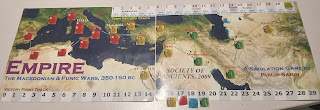That is 10 battles, each fought from the Allied side and then the French, with the book's AI controlling the opposing forces.
Despite the title, all the battles are from the Peninsular War, in a period covering August 1808 to May 1811.
My score in those 20 scenarios was 10-10 - actually, it was 11-10 in my favour, but that is because I was so disgusted with my generalship in one scenario that I immediately refought the battle, and won!
As you can see from my detailed accounts of the battles in this blog, most of the scenarios came down to the last turn with the outcome very much in the balance - sometimes literally decided with the last throw of the dice.
The book has just under 80 pages, complete with a page of counters that need to be cut out and, ideally, glued to some sort of base (I used 10mm-square steel bases from Jim Moore at Products For Wargamers).
 |
| Battles Of Napoleonic Europe - the cover shows a scene from a refight of the 19th scenario, the Battle of Fuentes de Oñoro, fought with the human commanding the Allies |
In the scenario depicted on the cover of the book, the human has Viscount Wellington, four units of infantry and one each of cavalry and artillery.
The AI commands Marshal André Masséna along with eight units of infantry, two of cavalry and one of artillery.
 |
| A selection of counters glued, somewhat carelessly, it has to be confessed, to steel bases |
Any wargame like this stands or falls on the strength of the AI, particularly whether the AI can put up a reasonable fight and whether the resulting battles have a realistic feel about them.
My score against the AI of 11-10, or 10-10 if you want to be picky, shows the AI can indeed put up a good fight, at least against someone who, while by no means a Napoleonic specialist, is fairly well-read in history and is an experienced wargamer.
As for whether the battles feel realistic, all I can say is that to me they certainly did.
True, the AI at times had problems using its artillery effectively, but then I was not immune from mistakes either, as the summing-up of my performance in the 19th scenario testifies.
Anyone who has played similar but earlier wargames by Mike Lambo may be surprised at how far the AI has come.
The emphasis is very much on Intelligence, rather than on Artificial, as the AI reacts to the human's moves, just as the human in turn reacts to what the AI is doing.
Each scenario starts with the human deploying either the Allied or French forces at the bottom of a map that is easily folded to lie plenty flat enough for play.
 |
| My deployment of the French at the Battle of Talavera |
 |
| In this case the AI went for a strengthened right wing |
The AI's moves are mostly decided by dice throws, although what each throw means varies by scenario and, often, by the particular situation in a battle, such as the specific disposition of the forces or the number of turns that have passed.
Sometimes dice are not involved, but whatever the exact mechanic, the key feature is that the human never has to make a decision for the AI - everything is governed by the rules.
And if the process sounds complicated, I can assure you it is not, and it was rare that I came across a circumstance where I was unsure how I should proceed on behalf of the AI.
This did happen a few times - maybe three? - but each time, after I posted my account of the battle at BoardGameGeek, Lambo confirmed that I had got it right.
In conclusion, if you are looking for a solo military experience that will challenge you as well as being a lot of fun, I cannot recommend Battles Of Napoleonic Europe highly enough.






.jpg)
































.jpg)
